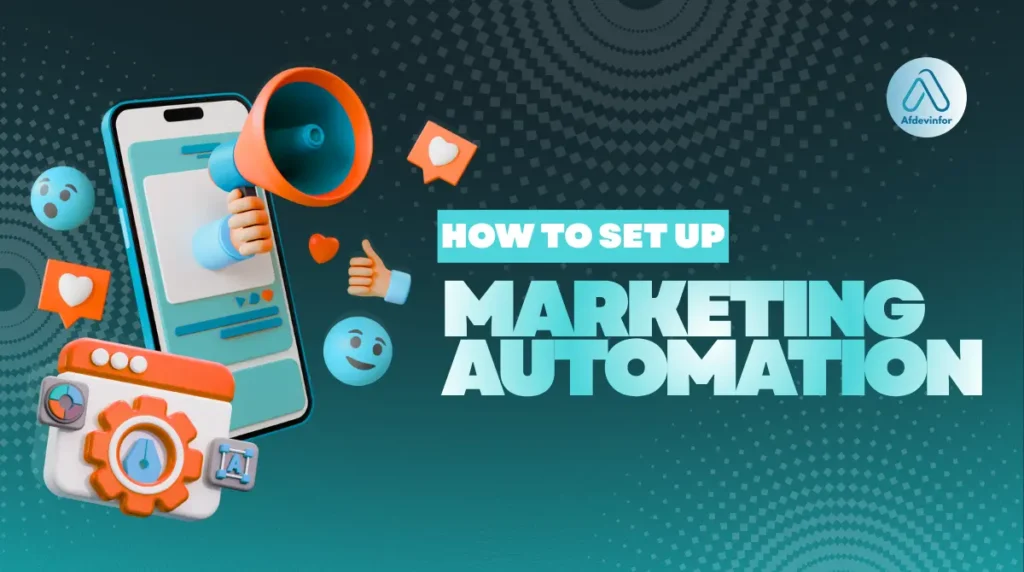In my experience, I’ve seen countless businesses get bogged down in the ‘how’ and completely miss the ‘why,’ which is why learning how to set up marketing automation correctly from the start is a game-changer. It’s easy to get lost in a sea of manual tasks, inconsistent lead follow-ups, and the overwhelming feeling of simply not knowing where to begin.
Imagine if every new lead was instantly engaged, every customer was nurtured, and your sales team only spoke to the warmest prospects – all while you slept. That isn’t a fantasy; it’s the result of a well-architected automation engine.
This article is my practical, tool-agnostic blueprint for building that engine. I’m not just going to list software; I’m going to position you as the architect of your own system. Here’s what I’ll walk you through in this guide:
- Strategy First: How to map your plan before you ever choose a tool.
- Step-by-Step Setup: The universal process for getting your system online.
- Tool Selection: A framework for choosing the right software for your specific needs.
- Avoiding Pitfalls: My hard-won advice on sidestepping the common mistakes that derail most automation projects.
1. What is marketing automation (and what it isn’t)?
Before we dive into the technical setup, it’s crucial we’re on the same page. At its core, marketing automation is simply using software to automate repetitive marketing tasks.
Think of it as building a highly efficient assembly line for your marketing processes. It takes tasks you’re already doing – like sending emails, segmenting contacts, or assigning leads to sales – and puts them on autopilot, allowing you to execute them at a scale and with a precision that’s impossible to achieve manually.
Its primary benefits are massive gains in efficiency, the ability to deliver personalization at scale, a significant improvement in lead quality, and, most importantly, a measurable Return on Investment (ROI).
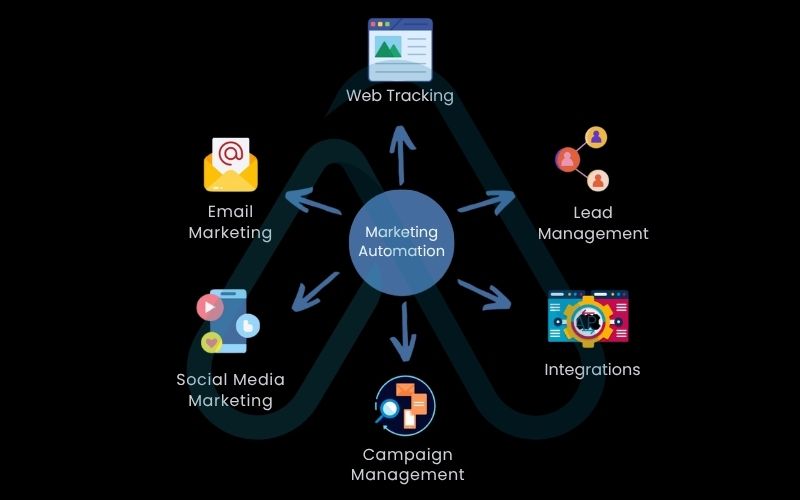
However, over the years, I’ve seen a lot of misconceptions derail projects before they even start. To clear the air, here’s a quick breakdown of the most common myths I encounter.
| Myth | Reality |
| It’s just for email. | Email is a core component, but true automation integrates your website, CRM, social media, and more to create a unified customer experience. |
| It’s a ‘set and forget’ solution. | It’s an engine that needs fuel and maintenance. It requires an initial strategy, ongoing monitoring, and continuous optimization to perform well. |
| It’s only for large enterprises. | With the rise of affordable and scalable tools, small and medium-sized businesses can benefit just as much, if not more, from automation. |
Core components of any marketing automation system
Every marketing automation platform, regardless of brand or price, is built on three fundamental components that work together. Understanding them is key to building effective campaigns.
These components are triggers, actions, and workflows. A Trigger is the event that starts an automation. An Action is the specific task the software performs once a trigger occurs. A Workflow (or sequence/campaign) is the series of actions that are logically strung together.
For example, a very simple sequence is: a user submits a form on your website (Trigger), which prompts the system to send them a welcome email (Action 1), and then adds them to a weekly newsletter list (Action 2). This entire process is the workflow. Visually, the relationship is linear and easy to grasp.
[Trigger: From Submission] -> [Action: Send Welcome Email] -> [Workflow: Add to Nurture Sequence]
Simple Flowchart
I always advise clients to think in this ‘Trigger -> Action -> Workflow’ model when planning. It simplifies complex processes into manageable pieces and ensures every automation has a clear purpose.
2. Mapping your automation strategy
Here’s the most important piece of advice I can give you: your strategy must always precede your technology. The number one reason I see marketing automation initiatives fail is that a company buys a powerful tool without a clear plan for how they’ll use it.
This section is your architect’s blueprint phase. Skipping it is like starting construction on a house without any drawings – it’s guaranteed to end in a costly mess.
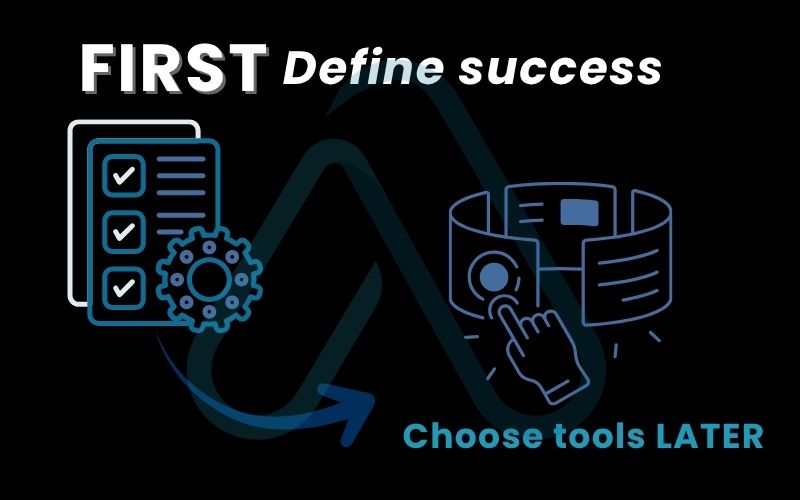
The goal is to identify the most repetitive, time-consuming, or high-impact processes in your marketing and sales cycle that can be improved with automation. Before you even look at software demos, you need to define what success looks like.
Are you trying to increase the number of qualified leads passed to sales? Improve customer retention? Re-engage dormant contacts? Be specific and set measurable goals, such as ‘increase our lead-to-customer conversion rate by 15% within six months.
| Warning A factory reset, especially when you choose the ‘Remove everything’ option, is permanent. Once the process is complete, your personal data on that drive is gone for good. Please follow this checklist meticulously. |
2.1. Defining your goals and KPIs
To measure success, you must first define it. Your automation goals should align directly with your broader business objectives. Here are some of the most common goals I help businesses set up, along with the Key Performance Indicators (KPIs) used to track them.
- Lead Generation: Increasing the volume and quality of new contacts.
- KPIs: Cost Per Lead (CPL), Number of new contacts, Form conversion rates.
- Lead Nurturing: Building relationships with prospects to guide them toward a purchase.
- KPIs: Marketing Qualified Lead (MQL) to Sales Qualified Lead (SQL) conversion rate, Email open/click-through rates, Time to conversion.
- Customer Retention: Increasing customer loyalty and lifetime value.
- KPIs: Churn rate, Repeat purchase rate, Customer Lifetime Value (CLV).
My advice is to choose just one or two primary goals to start. This focus will help you build your first workflow and will make it much easier to measure the success of marketing automation efforts early on.
2.2. Sketching your first marketing automation workflow
Before you ever log into a software platform, grab a pen and paper (or a whiteboard). The best way to design a clear and effective marketing automation workflow is to sketch it out visually first. This forces you to think through the logic without being constrained by a specific tool’s interface.
Let’s use a common example: an automated lead nurturing sequence for a lead magnet download. You’d start by mapping the key elements: the entry trigger (someone fills out the form to get your e-book), a sequence of timed emails, decision points (e.g., ‘did they click the link in Email #1?’), and a final goal (they book a demo or are passed to sales).
Your sketch should look something like a simple flowchart, defining the path a user will take. This process ensures your automated lead nurturing is logical and goal-oriented.
Mapping your marketing automation workflow this way makes the actual build process in your chosen tool ten times faster and more accurate. To help you get started, you can download our free workflow planning template here.
[Trigger: User Downloads Ebook] -> [Wait 1 Day] -> [Send Email 1: Case Study] -> [Decision: Did they click the link?]
Simplified Visual Flowchart Example
-> [YES: Add ‘Engaged’ Tag, End Workflow]
-> [NO: Wait 2 Days] -> [Send Email 2: Webinar Invite] -> [End Workflow]
3. How to set up marketing automation step-by-step
With your strategy and first workflow mapped out, you’re ready for the implementation phase. This is where we translate your blueprint into a functioning system. I’ll walk you through the core, tool-agnostic steps that apply to virtually any platform you choose.
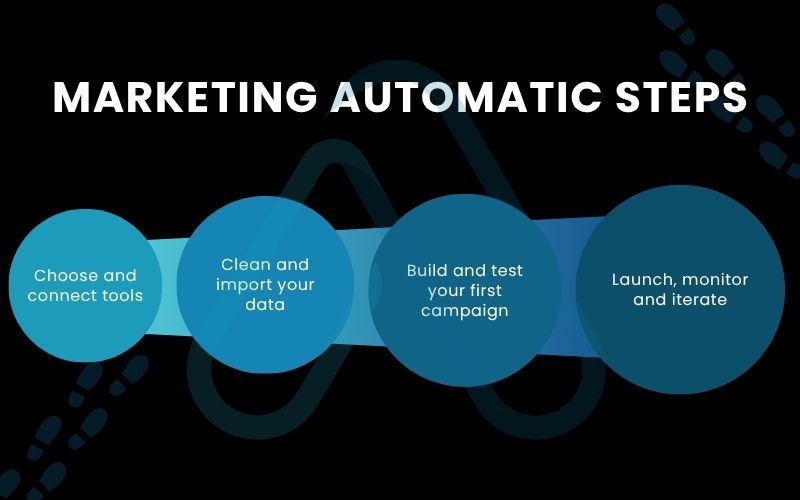
3.1. Choose and connect your core tools
Your marketing automation platform doesn’t operate in a vacuum; it needs to be the central hub connected to your other key systems, primarily your website and your Customer Relationship Management (CRM) software. The CRM integration for marketing automation is non-negotiable, as it allows for a seamless flow of data between your marketing and sales teams.
Most platforms offer two ways to connect: native integrations (often a simple, one-click setup for popular CRMs like Salesforce or HubSpot) or third-party connectors like Zapier, which provide more flexibility for connecting less common tools. You’ll also need to install a tracking script (usually a small piece of JavaScript) on your website to monitor visitor behavior.
Be warned: This is where technical pitfalls like data mapping errors often occur. Double-check that fields like ‘First Name’ in your automation tool correctly map to the ‘First Name’ field in your CRM.
| Warning During this integration phase, be mindful of data privacy regulations like GDPR and CCPA. Ensure your data handling processes are compliant and that you have the necessary consent from contacts before adding them to automated campaigns. |
3.2. Clean and import your contact data
I cannot stress this enough: your automation is only as good as the data you feed it. The ‘garbage in, garbage out’ principle is brutally true here. Before importing your contacts, you must perform a data hygiene audit. A clean database is the foundation of effective personalization and segmentation. If you import a messy list, you’ll get messy results and potentially damage your sender reputation.
Here is my essential checklist for data hygiene before an import:
- Remove Duplicates: Merge duplicate contact records to create a single source of truth.
- Standardize Fields: Ensure consistency in your data (e.g., ‘United States’, ‘USA’, and ‘U.S.’ should all be standardized to one format).
- Fix Formatting Errors: Correct typos and formatting issues in names, emails, and phone numbers.
- Segment Your Lists: Break your main list into smaller, more targeted segments based on criteria like lead source, industry, or past purchase behavior.
Once clean, import your contacts and apply tags. Tagging is the process of labeling contacts based on their interests or actions (e.g., ‘downloaded_ebook_q1’, ‘attended_webinar_may’). This is what will allow you to send highly relevant messages down the line.
3.3. Build and test your first automated campaign
Now it’s time to bring the workflow you sketched out in Section 2 to life. Using your chosen tool’s workflow builder, you’ll recreate the logic step-by-step. This involves creating the necessary assets: the emails for your nurture sequence, the landing page for your lead magnet, and the form to capture sign-ups. Most platforms have intuitive drag-and-drop editors for this.
Before you activate the campaign, you must test it rigorously. This is the step most people skip, and it’s where disastrous errors are made. Create a test contact using your own email address and run it through the entire workflow from start to finish. This ensures the logic works, the personalization is correct, and there are no broken links or typos. My email automation setup always includes a thorough check using a dedicated marketing automation campaign checklist.
Testing Checklist: Before you launch, confirm these items.
- Typos & Grammar: Read every email and landing page out loud.
- Link Functionality: Click every single link to ensure it goes to the correct destination.
- Tag & List Application: Verify that the correct tags are applied and the contact is added to the right lists at each stage.
- Time Delays: Double-check that the delays between steps are set correctly (e.g., 2 ‘days’ vs. 2 ‘hours’).
- Personalization: Make sure merge tags like `{{first_name}}` are pulling in the correct data.
3.4. Launch, monitor, and iterate
Once your tests are complete and you’re confident everything is working, it’s time to go live. Activate your workflow and let the system start running. However, your job isn’t done. The first 24-48 hours are a critical monitoring period. Keep a close eye on your key metrics to ensure everything is performing as expected.
This isn’t a ‘set and forget’ machine; it’s a dynamic system that requires ongoing optimization based on performance data. You’ll analyze the results, form hypotheses for improvement (e.g., ‘I think a different subject line will increase open rates’), and test them.
Here’s a list of key items you should be checking right after launch.
- Workflow Entry: Are new contacts entering the workflow correctly?
- Email Open/Click Rates: Are people engaging with your first email?
- Conversion Goal: Is the automation achieving its primary objective (e.g., demo sign-ups)?
- Unsubscribe Rate: Is there an unusually high unsubscribe rate, indicating a problem with your content or audience?
4. A framework for choosing the right tools
Now that you understand the process, we can talk about technology. My approach is to empower you to ‘build your own stack’ by making an informed decision, rather than just giving you a generic list of the ‘best marketing automation tools’.
The right tool for a solo entrepreneur is completely different from the right tool for a 50-person company. Your decision should be based on your unique needs, budget, and technical comfort level. For small business marketing automation, starting with a lean, focused tool is often the best path.
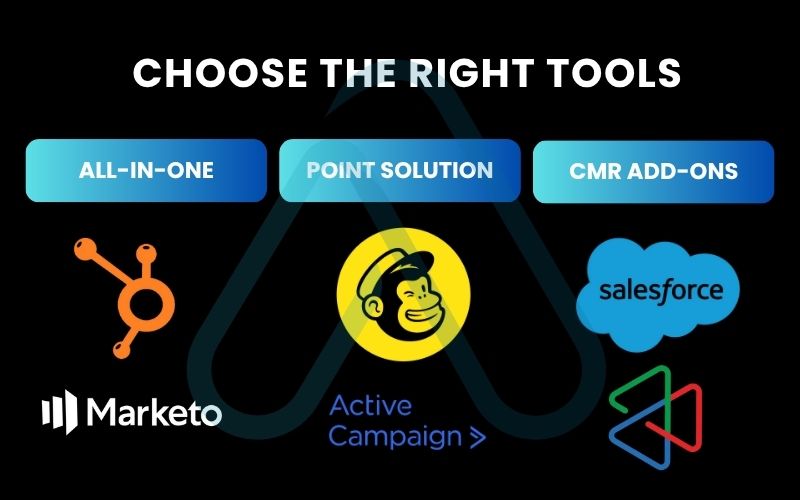
I generally categorize tools into three main tiers:
- All-in-One Suites (e.g., HubSpot, Marketo): These are powerful, comprehensive platforms that combine marketing automation, CRM, and sales tools. They’re great for larger teams that need a single source of truth, but can be complex and expensive.
- Point Solutions (e.g., ActiveCampaign, Mailchimp): These tools specialize in automation and email marketing. They are often more user-friendly and affordable, and they integrate well with other best-of-breed tools (like a separate CRM). This is my recommended starting point for most small to medium businesses.
- CRM Add-Ons: Many CRMs (like Zoho or Salesforce) offer their own marketing automation modules. This can be a convenient option if you’re already heavily invested in that CRM’s ecosystem.
4.1. Your tool selection flowchart
To help you decide which category is right for you, I’ve developed a simple decision-making flowchart. Ask yourself these questions in order to find your best fit. The text below explains how to navigate this mental flowchart.
First, ask: ‘What is my budget and team size?’ If you have a large budget and a dedicated marketing team, an All-in-One Suite might be viable. If you’re a small business or solopreneur, you should immediately focus on Point Solutions or CRM Add-Ons.
Next, ask: ‘What is my primary need?’ If your main goal is advanced email nurturing and behavioral segmentation, a powerful Point Solution is often the best choice. If your goal is simply to align sales and marketing activities within your existing CRM, then a CRM Add-On is the most logical path.
Finally, assess your technical skill. For those looking for the best marketing automation tool for beginners, the answer lies with platforms known for their user-friendly interfaces and strong customer support, which are most often found in the Point Solutions category.
4.2. Key features to compare
When you start comparing specific tools within your chosen category, it can feel overwhelming. To cut through the noise, focus your evaluation on these essential features.
| Feature | Description | Why it matters |
| Workflow Builder | The interface where you visually build your automated sequences. | This is where you’ll spend most of your time. It must be intuitive and flexible enough to build the logic you need. |
| Email Marketing | The tools for creating, sending, and tracking emails. | Look for a good editor, A/B testing capabilities, and solid deliverability performance. |
| CRM Integration | How well the tool syncs data with your CRM. | A deep, reliable integration is critical for sales and marketing alignment. Native is usually better than third-party. |
| Lead Scoring | The ability to assign points to leads based on their actions and demographics. | This automatically identifies your hottest leads so your sales team can prioritize them. |
| Reporting & Analytics | The dashboards and reports that show you how your campaigns are performing. | Without good data, you can’t optimize. You need clear insights into what’s working and what isn’t. |
| Landing Pages & Forms | Built-in tools to create pages and forms to capture new leads. | Having these integrated saves time and technical hassle compared to using separate tools. |
5. A small business case study
Theory is great, but seeing it in practice is better. To show you this isn’t just for enterprise giants, I’ll share a story based on a small B2B consultancy I worked with. It illustrates the real-world impact of a simple, well-executed automation strategy.
The Challenge
The firm, ‘Innovate Consulting’, hosted monthly webinars but struggled with follow-up. The sales team was manually sending emails to over 200 attendees after each event, a process that was slow, inconsistent, and resulted in many warm leads going cold.
The Solution
Instead of a complex, full-funnel automation, we started with one workflow: a post-webinar follow-up sequence. The trigger was ‘registered for webinar’.
The workflow then branched based on behavior: attendees received one set of emails with the recording and a case study, while no-shows received a different set with the recording and an invitation to the next event. Highly engaged leads (those who watched the replay and clicked the case study) were automatically tagged and assigned to a salesperson in the CRM for immediate personal follow-up.
The Results
The impact was immediate and profound. The consultancy saved over 10 hours of manual work per week. More importantly, because the follow-up was instant and context-aware, they increased their webinar-generated qualified leads by 30% in the first quarter.
Before this, our webinar follow-up was chaos. Now, it’s a machine that works for us 24/7. Our sales team is happier because they’re only talking to people who have already shown real interest, and our sales cycle has shortened measurably.
Fictional CEO, Innovate Consulting
6. 7 common setup pitfalls and how to avoid them
Over the years, I’ve been called in to fix more broken automation setups than I can count. The mistakes are almost always the same. Consider this my insider’s guide to help you sidestep the landmines that can sabotage your investment before you see a single dollar of ROI.
Here are the seven most common pitfalls and my advice on how to steer clear of them.
- Automating a Bad Process: Automation doesn’t fix a broken process; it just makes a bad process run faster. If your manual lead follow-up is ineffective, automating it will just make it ineffective at scale.
- How to Avoid: Before you automate anything, map and refine the process manually. Ensure it’s logical, efficient, and user-friendly first.
- Poor Data Hygiene: As I mentioned earlier, starting with a messy database of contacts is a recipe for disaster. It leads to embarrassing personalization errors (like `Hello {{first_name}}!`) and poor deliverability.
- How to Avoid: Commit to a thorough data cleaning process before you import a single contact. Make it an ongoing, quarterly task.
- Lack of a Clear Strategy: Buying a tool without knowing what you want to achieve with it. This leads to ‘random acts of automation’ that aren’t tied to any business goal.
How to Avoid: Complete Section 2 of this guide. Do not pass go, do not collect $200, until you have a written goal and your first workflow sketched out. - Over-Complicating Workflows: Building massive, 50-step workflows from day one. These are impossible to troubleshoot and optimize.
- How to Avoid: Start simple. Your first workflow should have a clear trigger, a few steps, and one goal. Add complexity later, only when necessary.
- Not Testing Thoroughly: Hitting ‘launch’ and hoping for the best. This is how you end up sending an email with broken links to 10,000 people.
- How to Avoid: Follow the testing checklist in Section 3.3 religiously. Create a test contact and run it through every possible path of your workflow.
- Ignoring Personalization: Sending the same generic message to everyone. This defeats one of the core purposes of automation, which is to deliver relevant content at scale.
- How to Avoid: Use the data you have! Segment your audience and use tags to trigger content that is relevant to a contact’s interests or behavior.
- Forgetting the Sales Team Loop: Creating a perfect nurturing system that never actually tells the sales team when a lead is hot and ready for a conversation.
- How to Avoid: Ensure your workflows include actions that notify sales (via email or a CRM task) and update the lead status in your CRM at the appropriate time.
7. Your troubleshooting and optimization checklist
Getting your first automation live is a major milestone, but the work of a true architect is never done. Marketing automation is a process of continuous improvement. This section provides a practical checklist for troubleshooting common issues and systematically optimizing your campaigns for better results.
7.1. Quick-fix troubleshooting guide
When something goes wrong, it’s usually due to a simple oversight. Before you panic or call support, I recommend running through this quick diagnostic table. It covers the most common problems I’ve seen and the very first thing you should check.
| Problem | First Thing to Check |
| Emails aren’t sending. | Check the workflow’s main ‘on/off’ switch. Is the campaign actually active? Also, check the sending schedule (e.g., is it set to only send on weekdays?). |
| Contacts aren’t entering the workflow. | Review the entry trigger conditions. Are they too specific or is there a typo? For a form submission trigger, fill out the form yourself to see if you enter the workflow. |
| Data isn’t syncing with the CRM. | Go to your integration settings. Has the connection been authenticated recently? Sometimes tokens expire and need to be re-authorized. Check the field mapping for errors. |
| Personalization tags are broken. | Check the contact record of someone who received a broken email. Is the data actually present in that field (e.g., is their ‘First Name’ field blank)? |
7.2. How to measure and optimize your automation ROI
To optimize, you need to measure. This is where you circle back to the goals and KPIs you defined in Section 2.1. Use your automation platform’s built-in analytics to track your performance against those KPIs.
The answer to ‘how do you measure the success of marketing automation?’ is simple: you compare your results against the specific, pre-defined goals you set at the very beginning. Are you hitting your MQL-to-SQL conversion rate target? If not, it’s time to optimize.
Optimization is a scientific process of testing and iterating. The best way to do this is through A/B testing, where you test one variable at a time to see what improves performance. Below are some simple tests you can run to improve your results.
- Email Subject Lines: Test a question-based subject line vs. a statement-based one to see which gets a higher open rate.
- Call-to-Action (CTA) Copy: Test different button text (e.g., ‘Learn More’ vs. ‘Get the Guide’) to see which drives more clicks.
- Time Delays: Test the timing between your emails. Does a 1-day delay perform better than a 3-day delay for your audience?
- Sender Name: Test sending from a person’s name (e.g., ‘John from Afdevinfo‘) vs. the company name to see if it impacts open rates.
8. FAQs about how to set up marketing automation
What are the first steps to set up marketing automation?
To set up marketing automation, follow these 5 steps:
- Define Goals: Set objectives and metrics.
- Prepare Data: Clean and segment your contact list.
- Setup Tools: Choose a platform and integrate it.
- Build & Test: Create and test your workflow.
- Launch & Optimize: Go live and improve continuously.
Which marketing automation tool is best for beginners?
The best marketing automation tool for beginners is one that is user-friendly, offers strong customer support, and integrates well with your existing tools. Point solutions often fit these criteria. Use the selection framework in Section 4 to help choose.
How do you integrate CRM with marketing automation?
You can integrate CRM with marketing automation in two ways:
- Native Integration: Use a one-click integration from the marketing automation platform for popular CRMs, which is stable and feature-rich.
- Third-Party Connectors: Use tools like Zapier or Make.com to pass data between systems, offering more flexibility.
What common mistakes should you avoid when implementing marketing automation?
When implementing marketing automation, avoid these common mistakes:
- Automating Inefficient Processes: Don’t automate broken manual workflows.
- Using Bad Data: Clean, standardize, and segment your contact data before import.
- Skipping Strategy: Set clear, measurable goals before diving in.
- Over-Complicating Workflows: Start with simple workflows instead of complicating them.
Glossary of key terms
| Abbreviation | Full Term | Meaning |
| CRM | Customer Relationship Management | Software used to manage a company’s interactions and relationships with customers and prospects. |
| ROI | Return on Investment | A performance measure used to evaluate the efficiency of an investment. For automation, it compares the gain from the investment relative to its cost. |
| KPI | Key Performance Indicator | A quantifiable measure of performance over time for a specific objective. |
| MQL | Marketing Qualified Lead | A lead who has engaged with marketing efforts but is not yet ready for a sales call. Judged more likely to become a customer compared to other leads. |
| SQL | Sales Qualified Lead | A prospective customer that has been researched and vetted by the marketing and sales teams and is deemed ready for the next stage in the sales process. |
| GDPR | General Data Protection Regulation | A regulation in EU law on data protection and privacy for all individuals within the European Union and the European Economic Area. |
| CCPA | California Consumer Privacy Act | A state statute intended to enhance privacy rights and consumer protection for residents of California, United States. |
| API | Application Programming Interface | A set of rules and protocols that allows different software applications to communicate with each other. |
8. Final thoughts
As we’ve walked through this entire process, from high-level strategy to the nuts and bolts of troubleshooting, one core principle should be crystal clear: successful marketing automation is 80% strategy and 20% technology. The software is just the tool; your plan is what drives the results. By focusing on a solid foundation, starting small, and committing to continuous improvement, you can build a powerful marketing engine that saves time, improves relationships, and drives measurable growth for your business.
Here are the most critical takeaways I want you to remember:
- Strategy Before Software: Never buy a tool until you have a clear, written plan for your first campaign.
- Data is Everything: The quality of your data will directly determine the quality of your results. Do not skip the data hygiene step.
- Start Simple, Then Scale: Master one simple, high-impact workflow before you try to automate your entire customer journey.
- Test, Monitor, Optimize: Automation is not ‘set and forget.’ Your work truly begins after you launch, as you analyze data and iterate for better performance.
Your journey starts now. Pick one repetitive task this week and sketch out a simple ‘Trigger -> Action’ workflow on paper. You’ll be surprised at what you can build. For more in-depth guides to help you master your digital strategy, explore our Digital Marketing Strategies on Afdevinfo.


